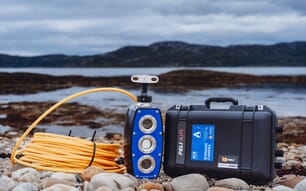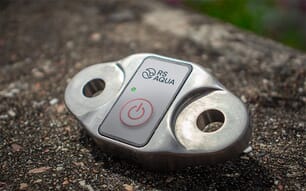
The project links offshore wind energy and aquaculture production on a floating platform © W2Power
The AquaWind project sparked great interest at the Cádiz National Aquaculture Congress, held in the Andalusian Conference Centre, as it showcased leading tech across the fish farming and renewable energy sectors. Under the slogan “Aquaculture: seas and rivers of opportunities” of the XVIII National Aquaculture Congress, the AquaWind presentation touched on key themes of the conference. The project links offshore wind energy and marine fish production in the same floating platform. The initiative promises to bring real development opportunities at the national level, both in the field of fish farming, renewable energy and blue growth, as well as being an example of entrepreneurship and a potential source for job creation.
The coordinator of the project, Javier Roo, head of R+D+i projects at the Canary Islands Agency for Research, Innovation and the Information Society of the Government of the Canary Islands (ACIISI), focused his speech at the congress on the research and development of prototypes, with the presentation of the AquaWind platform.
“We must remember that it is the only European initiative that combines the production of renewable energy on the high seas and fish farming in the first floating wind platform in Spain, capable of jointly producing wind energy and high-quality fish,” said Roo, who also represents the University Institute for Research in Sustainable Aquaculture and Marine Ecosystems (IU-ECOAQUA) of the University of Las Palmas de Gran Canaria (ULPGC).
During his speech at the Palacio de Congresos in Cadiz, the AquaWind coordinator clarified that one of the main innovations of the project will be to be able to, “evaluate in a real environment the combination of production and use of renewable energy in fish aquaculture”. In addition, during the project, work will be done with two species of fish of enormous aquaculture interest, such as sea bream, and a new species for the diversification of marine aquaculture, such as seriola (better known as amberjack) characterised by its high value and culinary interest, particularly in the Japanese cuisine. Another advantage of combining various activities is that the occupation of marine space and the visual impact on the coast are simultaneously reduced.
A press release from the company explains that the project features a W2Power prototype offshore wind generator that was developed by EnerOcean. The W2Power concept aims to be a profitable floating wind solution that reduces the overall cost of energy by relying on two large-capacity wind turbines to generate renewable electricity. Due to its size and stability, the platform can accommodate additional functions such as energy storage or harnessing wave energy, as well as aquaculture.
As the project moves forward, AquaWind is taking action to engage with stakeholders and conduct impact assessments. “We have taken this opportunity to share a survey that has been prepared to collect the expert vision of representatives of the entities participating in the congress, as well as the scientific community interested in the aquaculture sector,” the project coordinator explained.

AquaWind has been 80 percent co-financed with more than €1 million by the European Climate, Infrastructure and Environment Executive Agency, thanks to the European Maritime, Fisheries and Aquaculture Fund, the remaining 20 percent corresponding to own funds from the partners of the project.
Click here to learn more about the project and its partners.




